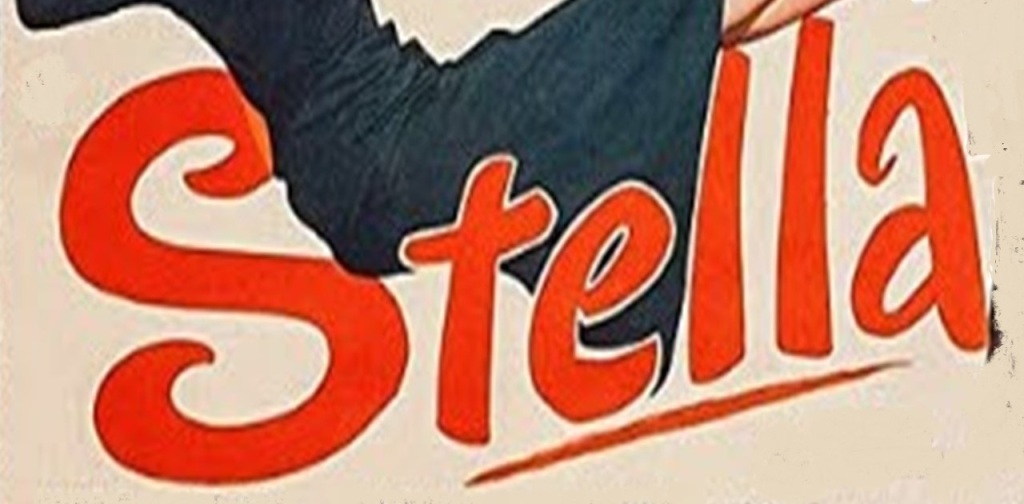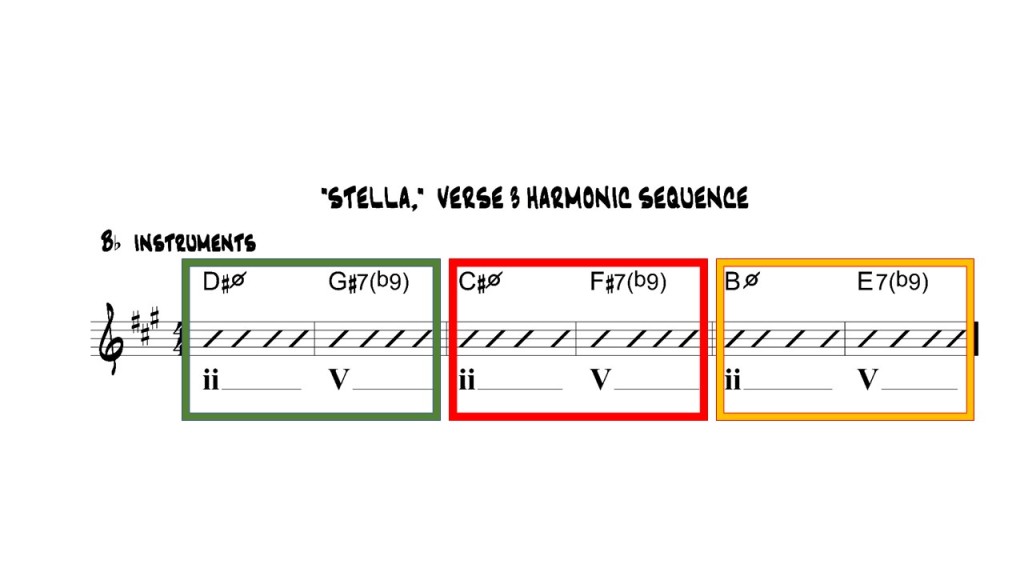
Yesterday, I discovered a sequence in Stan Getz’s 1952 Clef recording of “Stella by Starlight,” (MGC 137). The three-by-three format unfolds as Stan finishes the bridge on his first chorus. Here it is:

If you’ve studied “Stella,” you know that the final 8 bar section of the form contains the intriguing 6-bar harmonic sequence shown below:

As shown here, that harmonic sequence features 3 iterations of 8 beats each, for a total of 24 beats. But Getz begins his amazing melodic sequence 2 beats before the passage shown above, so he needs to fill 26 beats.
The diagram below illustrates the incredible way he accomplishes this Herculean feat. Stan’s motif of six eighth-notes covers 3 beats and is repeated three times on each of three starting notes. But on the second iteration of round two, he leaves out a beat. Thus, the total episode comprises 9 + 8 + 9 = 26 beats. Even at 160 beats per minute, Getz is able to execute this monumental feat so smoothly that it sounds effortless.

Playing through transcribed solos of the masters at slow tempos is an eyeopening experience, because their melodic lines make equal sense at any tempo. For the most part, even though originally executed at blinding speeds, the internal logic of these timeless improvisations holds together perfectly, offering the listener a sense of unity, variety, and coherence, as if carefully and meticulously composed.
To what extent are these compositional masterpieces actually improvised on the spot? Obviously, great players are intimately familiar with every aspect of the underlying song being performed. And yet, their solos come off sounding so spontaneous and fresh. What are your thoughts about this paradox?
“Stella by Starlight” has been a favorite for numerous players since its introduction in 1944, and an abundant array of wonderful recordings is available for you, if you need fresh ideas for navigating these invigorating changes. Stan Getz produced at least two exceptional recordings of “Stella” that I know of. Each is great, although they are distinctly different from one another. Here’s his 1952 recording in its entirety:

Hi, Craig—
I’m “burning the midnight oil” again tonight, working on charts and watching late-night “geezer” TV.
I just checked out the passage you posted, along with your transcription. I think it’s great you are doing this. It’s beneficial to students, and to pros as well.
This phrase is, I think, very lyrical and beautiful. I played it several times, and was trying to figure out if this was something he had worked out in advance, or actually improvised on the spot. It really doesn’t matter: it’s his, and it’s terrific.
I’ll be stealing it soon, ha, ha!
It seems that whenever I try something like this, I’ll lose my place! This bears some close study, and—here it comes—practice!
Thanks for sending it, and for thinking of me.
On to a new, much better year!
LikeLike
Great to hear from you, Dan!
I was listening to one of your amazing recordings last night.
You know, jazz is one of the few arenas in which “stealing” (“borrowing,” “seeking mentors,” “being influenced by”) other players is not a crime, but rather is encouraged by those who wisely counsel us to emulate the great masters of our art.
Your reminder to “practice” brings to mind the wonderful story in Gene Lee’s fantastic book***, where a bunch of musicians are standing around in front of Jim And Andy’s, when a woman drives up and asks, “How do you get to Carnegie Hall?” But then it occurred to me that you probably have already performed on that hallowed stage!
*** https://www.amazon.com/Meet-Me-Jim-Andys-Musicians/dp/0195046110
LikeLike
Craig, Good to hear from you. In looking at your analysis of what he played-chords, pitches, intervals and time- I think you are correct that that is what he played. But the real question here (to me) is what he was thinking as he was playing this. Was he actually thinking the chords, pitches, etc. as you have written it down (with all the complexties now on paper) or was he simply playing something on the spur-of-the-moment he thought would sound good? He was obviously the caliber of player who could have easily come up with this without a moment’s forethought. I don’t much think he would have spent any time at all working this out in advance so he could stick it in the next time he he played this tune. He wouldn’t need to. So I think we’re probably overthinking this. Getz was certainly a wonderful player (although, likely, not a wonderful person). I suspect that if you try this with some of your own solos (unless you are actually thinking chords), you will be astonished to discover that you are really an even far more brilliant player than your fans already think you are! Best wishes. Clive
LikeLike
Gosh! Thanks a million, Clive. Back at ya’, brother! The few times i was privileged to perform with you were a joy and an inspiration.
Of course, you are correct; once we’re up on the bandstand counting off the next tune, we journey to another realm in which “the 10,000 hours of preparation” give way to (or allow us to) play spontaneously the feelings in our hearts.
That said, i continue to marvel at what those who have gone before us have produced.
I’ve been working on a Benny Carter solo for several weeks, and the ability to reach Benny’s level of “effortless mastery”*** remains daunting.
*** https://kennywerner.com/effortless-mastery
LikeLike
Very interesting observation, analysis and presentation Craig. It makes me think a lot of Paul Desmond’s approach. It might be interesting to see if he uses poly-rhythmic sequences (for lack of a better term) elsewhere in his music. My guess is that something like this is the result of years of performing, fairly spontaneous and not careful planning. I’ll ask him next time I see him.
LikeLike